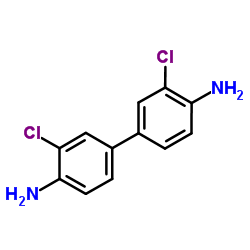Determination of hemoglobin adducts formed in rats exposed orally with 3,3'-dichlorobenzidine by GC/MS-SIM.
Jin Heon Lee, Ho-Sang Shin
Index: Toxicol. Ind. Health 18(4) , 191-9, (2002)
Full Text: HTML
Abstract
3,3'-dichlorobenzidine (DCB) can be metabolically N-acetylated and/or N-oxidized, and can form hemoglobin adducts. Gas chromatography/mass spectrometry-selected ion monitoring detection mode (GC/MS-SIM) could be a good analytical method to detect them. 4-Aminobiphenyl and phenanthrene-d10 were used as internal standards, and standard metabolites of DCB were synthesized from DCB. Pyridine is a promoter and acetic acid is a controller in the acetylation of DCB during titrating with acetyl chloride. After washing with acetone, the purity of N-acetyl DCB and N,N'-diacetyl DCB were 98.72% and 98.82%, respectively. The maximum detection limits (MDLs) by GC/MS-SIM were 0.5 microg/L in DNA adduct and 1.0 ng/g in hemoglobin for DCB and N-acetyl DCB. The base peaks of their fragmentation pattern were 252 m/z at the peak of DCB, 252 m/z and 294 m/z at the peak of N-acetyl DCB, and 252 m/z, 294 m/z, and 336 m/z at the peak of N,N'-diacetyl DCB. This analytical method was applied to determine hemoglobin adducts formed in young female Sprague-Dawley rats orally exposed with 20, 30, and 40 mg DCB/kg/day for three weeks. Two adducts were detectable by GC/MS-SIM after alkaline hydrolysis of hemoglobin samples and extraction. The structure of these adducts could be assigned to DCB and N-acetyl DCB by co-chromatography with the synthetic standards. After the first week of treatment, the total amount of hemoglobin adducts determined was 837.5 approximately 2501 ng/g hemoglobin. The adduct levels were increased up to 1203.3 approximately 2605.4 ng/g after the second week, and slightly decreased after the third week. The ratio of DCB and N-acetyl DCB was nearly similar in all treatment groups at the third week, such as 4.28 approximately 4.78. Three different treatments (20, 30, and 40 mg DCB/kg) of rats resulted in dose-proportional increases in the total and DCB amount of hemoglobin adducted formed for three weeks. The relative contribution of DCB and N-acetyl DCB to the total hemoglobin adduct level was strongly dose dependent. The results show that GC/ MS-SIM is suitable for the biological monitoring of humans exposed to DCB or DCB-containing products.
Related Compounds
| Structure | Name/CAS No. | Molecular Formula | Articles |
|---|---|---|---|
 |
3,3'-Dichlorobenzidine
CAS:91-94-1 |
C12H10Cl2N2 |
|
Evidence that 4-aminobiphenyl, benzidine, and benzidine cong...
2007-06-01 [Environ. Mol. Mutagen. 48(5) , 404-13, (2007)] |
|
Photodechlorination of 3,3'-dichlorobenzidine in water.
2002-03-01 [Environ. Toxicol. Chem. 21(3) , 500-6, (2002)] |
|
Determination of dichlorobenzidine-hemoglobin adducts by GC/...
1997-01-01 [Int. Arch. Occup. Environ. Health 69(4) , 240-6, (1997)] |
|
Sorption of benzidine and 3,3'-dichlorobenzidine to lake sed...
2005-05-01 [Environ. Toxicol. Chem. 24(5) , 1022-8, (2005)] |
|
Transport behavior of 3,3'-dichlorobenzidine in a freshwater...
2003-01-01 [Environ. Toxicol. Chem. 22(1) , 20-5, (2003)] |